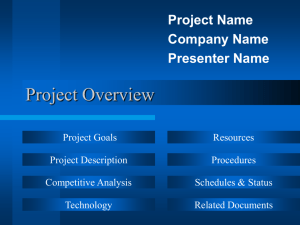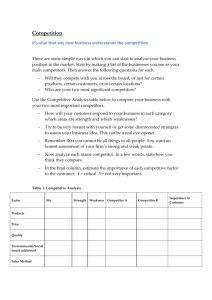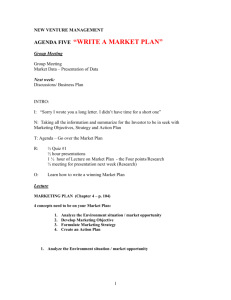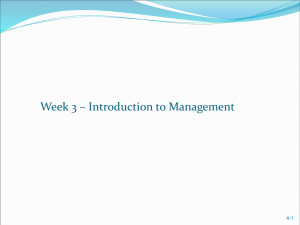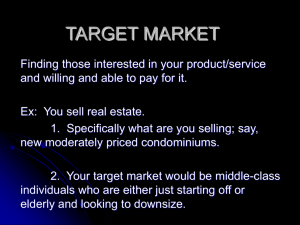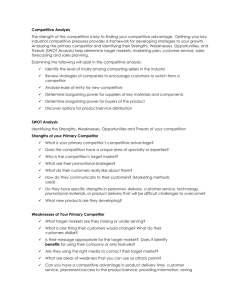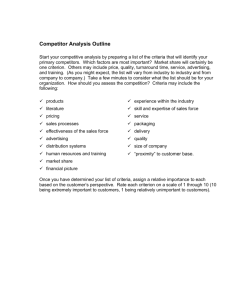Lindell's Lecture Notes CHAPTERS 3 & 4 B (supplement
advertisement
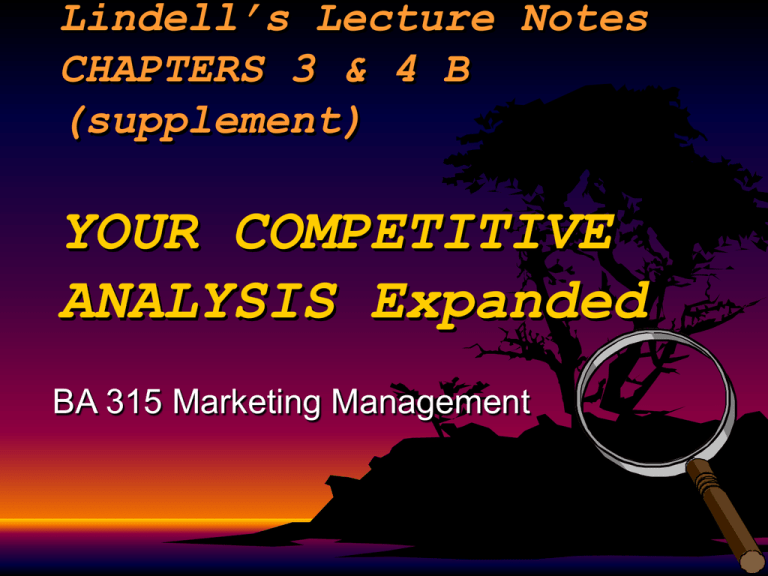
Lindell’s Lecture Notes
CHAPTERS 3 & 4 B
(supplement)
YOUR COMPETITIVE
ANALYSIS Expanded
BA 315 Marketing Management
Market Structure and
Competitor Analysis
Performing
a market analysis to
identify your major competitors.
Performing a competitor
analysis.
Alternative sources of
information for analyzing
competitors
Analyze Critical Development
of Marketing Plan
Defining
the competition is
important in determining which
products are competing.
Studying competitors is crucial
to develop a value proposition.
It is beneficial to anticipate
competitor’s moves and act in a
preemptory fashion.
Market Structure Analysis
A
market structure analysis
enables the marketing manager
to understand the competition.
Overlooking an important
competitive threat can be
disastrous.
Ambiguous definition of the
competition creates uncertainty.
Different Terms Used in
Defining a Market
Industry.
Product
class.
Product types.
Product brands.
Competition Is Defined by the
Customer
Product
form competition - includes only
products or services of the same product type.
Product category competition - products that
have similar features and provide the same
basic function.
Generic competition - incorporates the
customer’s notions of substitutability.
Budget competition - products and services
that are purchased from the same general
budget.
Competition Is Defined by the
Customer
Product
form
competition - includes
only products or services of
the same product type.
Competition Is Defined by the
Customer
Product
category
competition - products that
have similar features and provide the
same basic function.
.
Competition Is Defined by the
Customer
Generic
competition -
incorporates the customer’s
notions of substitutability
Competition Is Defined by the
Customer
Budget
competition -
products and services that are
purchased from the same general
budget.
Critical DifferencesCompetitor Levels
Product
form or product category competition
are inward oriented.
Generic competition is outward oriented.
Product form and product category
competitors are defined by product that look
like yours.
Generic competitors are defined by looking
outside the firm to the customers.
The Marketing Manager’s Job
Product
form level - marketing activities
directly aimed at similar competitors.
Product category level - you must
convince customers that the product
form is the best.
Generic competition level - you must
convince customers the product
category solution is superior
Customer Target Change
Product
form competition
involves battling for exactly the
same customers.
Generic competition can
destroy entire product
categories when a major
innovation occurs
Measurement Issues
Government
documents provide
valuable information about
product form and category
competitors.
Consulting firms, trade
associations, and professional
publications may supply own
product category data.
Cross-Elasticity of Demand
Indicator
of substitutability.
Percentage change in one
product’s sales due to a
percentage change in a marketing
variable for another product.
Cross-elasticity - price is positive,
the two products are considered to
be competitive.
Competitor Strengths and
Weaknesses
The
ability of the competitor to conceive
and design new products.
The ability of each competitor to
produce the product.
The ability to market.
The ability to finance.
The ability to manage.
Competitor Strengths and
Weaknesses
The
ability of the
competitor to
conceive and design
new products.
Competitor Strengths and
Weaknesses
The
ability of each
competitor to
produce the
product.
Competitor Strengths and
Weaknesses
The
ability to
market.
Competitor Strengths and
Weaknesses
The
ability to
finance.
Competitor Strengths and
Weaknesses
The
ability to
manage.
Competitor Analysis
A determination
of the competitors’
major objectives.
An assessment of their marketing
strategies.
An assessment of their strengths and
weaknesses.
An internal analysis of your firm’s
strengths and weaknesses relative to
competitors
Competitor Strategies
Marketing
managers must
monitor:
– Segments pursued.
– Competitors targets.
– Product features.
– Core strategy.
–Supporting marketing mix.
Customer and Competitor
Target
Product
sales literature.
Your own sales force.
Trade advertising.
Core Strategies
Studying
their marketing
communications.
How are they differentiating
themselves?
What is their value
proposition?
Supporting Marketing Mix
Price
- What is the pattern of price
change over time?
Communication - What advertising
media are being used?
Distribution - What kinds of selling
approaches are being used?
Product capabilities - a comparison of
capabilities is useful.
Expected Future Strategies
Sometimes
competitors tell you what
their future strategy will be.
Identifying a trend in their past actions
and extrapolating it into the future.
Forecast competitors’ action by
simulating them.
Use scenario planning.
SWOT Analysis
Strengths.
Weaknesses.
Opportunities.
Threats
Secondary Sources
Internal
sources.
Annual reports.
Patent and trademark filings.
General business and trade
publications.
Consultants.
Trade associations.
Help wanted ads.
Electronic data services.
Primary Sources
Sales
force and customers.
Employees.
Suppliers.
Reverse engineering or sampling.
Competitors’ products.
Plant tours.
Internet newsgroups.
YOUR COMPETITION: Even
though you may have done a
great job in pinpointing and
studying your market segment
the job isn't done until you have
considered your competition.
• My main competitors in my
market area are:
Name of firm (list)
YOUR COMPETITION: Based on
my market research of statistical data
(such as Sales Management) the
amount of buying power per business
represented in my area for this kind of
business is $-. If 1 can generate that
amount of sales, it: will be sufficient
for me to operate successfully.
• Five reasons why customers would buy from me rather than my competitors
are:
• Five weaknesses my business will have, in comparison to my competitors,
are:
In order to overcome these weaknesses, I will:
STEPS OF COMPETITIVE ANALYSIS
1. DEFINE THE TARGET MARKET
2. DEFINE THE DIRECT COMPETITORS (SERVING THE
SAME MARKET
SEGMENT(S)
USE...PERCEPTUAL MAPPING
A. MULTIDIMENTIONAL
SCALING
B. FACTOR ANALYSIS
3. ASSESS COMPETITIVE DYNAMICS
A. PIONEERING ADVANTAGE
B. POTENTIAL FOR
TECHNOLOGY DISCONTINUITY
C. IDENTIFY FUTURE COMPETITORS
(NEW ENTRANTS)
D. BARRIERS
STEPS OF COMPETITIVE ANALYSIS
4. ASSESS COMPETITIVE INTENSITY-INCLUDE
CONDITIONS THAT FOSTERS INTENSE
COMPETITION
5.IDENTIFY AVENUES FOR ATTAINING A
SUSTAINABLE ADVANTAGE OVER
COMPETITION
6.SOURCES OF COMETITIVE INTELLEGENCE
YOU MAY COMBINE STEPS 3 AND 4 INTO
COMPETITIVE MARKET FORCES
Chapter Objectives
1. To gain an appreciation of the
need for performing
competitive analysis.
2. To understand the five step
approach to carrying out a
competitive analysis.
3. To become acquainted with
perceptual mapping and the
techniques used.
4. To gain an appreciation and
awareness of sources of
competitive intelligence
Definition of the target
market
We
establish the
product market
boundaries of
interest and
identify any
specific target
segments.
identifies direct
competitors
who
are likely to gain or
lose a substantial
customer share over time
because they serve the
same customers and offer
similar benefits.
perceptual mapping
Perceptual
mapping methods are
used to position the firm against
competitors as seen by the
consumer. Product positioning is
used to determine the brands that
consumers see as being similar.
perceptual mapping
Managers
rely on some
perceptual mapping
techniques to portray how
customers perceive the
various market competitors.
There are two types:
Multidimensional
scaling relies on
similarity judgments of
consumers in
determining the degree
of similarity between
pairs of products.
A factor analysis based
approach relies on buyers
assessment of
determinant attributes to
evaluate alternatives
ALMOST HOME
THE BATTLE FOR THE
COOKIE MARKET
– In 1982, marketers in the cookie
industry received a
doublebarreled attack with the
entrance of Procter & Gamble's
Duncan Hines cookies and Frito
Lay's Grandma's brand.
Initially, both lines were
successfully test marketed in
Kansas City, and by 1983, Frito
Lay had begun moving into a
variety of other markets.
ALMOST HOME
THE BATTLE FOR THE
COOKIE MARKET
1. Multidimensional scaling relies on
similarity judgments of consumers in
determining the degree of similarity
between pairs of products.
2. A factor analysis based approach
relies on buyers assessment of
determinant attributes to evaluate
alternatives
perceptual mapping
NOW
APPLY YOUR ADVENTURE
WITH YOUR SUPERMARKET
FROZEN FOODS EXCURSION.
YOU,
THE TARGET RATED 10 TV
DINNERS
Assessing competitive
dynamics
Assessing
competitive
dynamics, step 3 of the
competitive analysis,
involves attempting to
project what the future
competitive environment
will look like.
Pioneering advantage
{HOYLE SCHWEITZER invented
WINDSURFER(ing)}
is the market
advantage that results
from a competitor
being the innovator in
a market. Several
factors contribute
to this advantage:
1.Pioneer products act as
"prototypes" for
competitors.
2. Initial brands
potentially build
significant loyalty.
3. Late entrants will
have difficulty obtaining
awareness and trail by
distributors and
consumers.
Pioneering
advantage
If the future competitive
structure of a market is
to be understood, managers
should attempt to
determine the potential
for technological
discontinuity. Note- LPC
WINDSURFER EXAMPLE
Steps of competitive analysis (continued)
Although the identity
of current direct
competitors is
important, it is
equally essential to
identify future
competitors, i.e., new
entrants.
Such as…MISTRAL,BIC
Steps
of competitive analysis (continued)
Barriers to entry make
it difficult to become
a significant competitor in a
new market.
PLEASE REFERENCE OUR
HANDOUT ON INDUSTRY
ATTRACTIVENESS in your
packet
Steps
of competitive analysis (continued)
Barriers to entry Economies
of scale, initial financial
investment, lack of access
to sources of production,
and limited access to
distribution channels are
some typical barriers to
entry.
Steps
of competitive analysis (continued)
Barriers to entry …Tariffs,
quotas, customs, and
governmental intervention
are some international entry
barriers.
Steps
of competitive analysis (continued)
New entrants can cause
considerable competitive
concern through improved
price performance trade
offs, by bringing new
skills to the industry,or
by virtue of cross
subsidizations.
Steps
of competitive analysis (continued)
The importance of
assessing competitive
intensity, step 4, is
twofold: to determine the
likely cost of meeting
competition and to
recognize the most
important bases and types
of competition.
Steps
of competitive analysis (continued)
Several basic conditions which
foster intense competition are:
numerous competitors, slow
industry growth, undifferentiated
products and services, low
switching costs, significant
economies of scale, industry
overcapacity, and management
loyalty
Steps
of competitive analysis (continued)
The ultimate purpose of
performing a competitive
analysis is to identify
possible avenues for
attaining a sustainable
advantage over competitors
so as to achieve product
or product line
objectives.
Steps
of competitive analysis (continued)
In assessing competitive
advantage, managers must
identify the positions and
sources of advantage that
lead to desired market
performance outcomes.
.
Steps
of competitive analysis (continued)
1. Positional
advantages depend on
the customer's
perception of these
advantages.
Steps
of competitive analysis (continued)
2. Source advantages
include: skills of people
within the organization, the
systems or arrangement
developed for market
response, and the
organization's resources.
. Steps of competitive analysis
(continued)
3. Superior resources,
intangible and tangible, can
enable a firm to either
underprice the competition or
to offer better or unique
performance.
. Steps of competitive analysis
(continued)
Sources for obtaining
competitive intelligence
fall into three basic
categories: published
material & documents,
competitors' employees,
suppliers, or customers;
and direct observation.
Steps
of competitive analysis (continued)
PLEASE REFERENCE OUR
HANDOUT... INDUSTRY
ATTRACTIVENESS SUMMARY
AGGREGATE
MARKET
FACTORS
INDUSTRY FACTORS
ENVIRONMENTAL
FACTORS
PLEASE , ALSO,
REFERENCE THE BOOK
THE ART OF WAR
LPC1@UMSL.EDU
Competitive analysis-LPC@umsl.edu
Don’t forget your handout packet: An exam
question: We analyze a competitor on five
abilities…..
The abilitiy to………..
